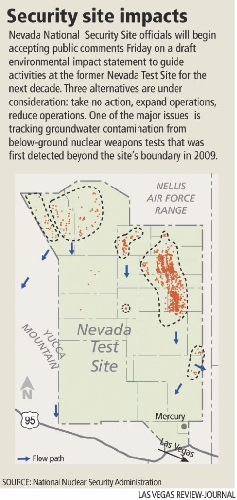Draft analyzes options for Nevada National Security Site
Nevada National Security Site officials released a lengthy draft impact statement Monday that analyzes options for guiding activities over the next decade at the former Nevada Test Site.
The 1,576-page draft Site-Wide Environmental Impact Statement Nevada covers operations by the Department of Energy's National Nuclear Security Administration at the site, 65 miles northwest of Las Vegas, and off-site locations.
The agency will accept public comments on the document from Friday through Oct. 27.
Among the major issues addressed in the document is the program that tracks and characterizes radioactive contamination from full-scale, below-ground nuclear weapons tests conducted until they were put on hold indefinitely in 1992.
Other prominent potential activities include development of solar energy demonstration projects and commercial solar power facilities.
In addition, the report looks at the test site's role in counterterrorism programs, use of its device assembly facility, training first responders and disposing of low-level radioactive waste from the nation's Cold War-era nuclear weapons production facilities.
Government contractors and scientists from national laboratories in Livermore, Calif., and Los Alamos, N.M., use the site to conduct physics experiments to ensure that existing U.S. nuclear weapons are safe and reliable.
The draft impact statement will replace one that has guided test site activities since 1996, said Darwin Morgan, spokesman for the National Nuclear Security Administration's North Las Vegas office. The report contains more than 700 separate documents on the spectrum of activities examined under three alternatives: take no action, expand operations or reduce operations.
"Once we have gone through all the comments, we'll issue a final impact statement, which will include a record of decisions that could be one or a combination of the three alternatives," Morgan said.
The draft report details the site's environmental program for tracking contamination, particularly in the site's Pahute Mesa area. That's where tritium from nuclear weapons tests was first detected beyond the test site's boundary in 2009.
The isotope had migrated two miles through groundwater layers in 35 years to reach the boundary.
Scientists think it will take roughly 240 years for the tritium-laced water to travel another 14 miles to the nearest public water source. By that time it will have decayed to non-detectable limits. Currently, the contamination is within a secure area of the Air Force's Nevada Test and Training Range.
In all, 82 underground nuclear tests were conducted in Pahute Mesa out of at least 828 throughout the Nevada Test Site from 1951 to 1992, plus 100 above-ground shots.
"We're doing the models to make sure we know its extent and where it's moving and how fast it's moving," Morgan said about the characterization program.
"In 20-plus years time frame, we'll start looking at what if any remediation needs to be done and what would be remediation activities in place. But we have enough lead time so we can focus on characterization activities right now."
While tritium is an indicator of radioactive remnants from nuclear explosions, scientists are trying to determine how fast longer-lived isotopes, such as those from plutonium and neptunium, are traveling. They think those heavier radioactive materials that persist in the environment are migrating at a much slower pace.
Tainted water is emanating from areas where devices for the Benham and Tybo nuclear tests were exploded in 1968 and 1975, respectively. Benham, the more powerful of the two, produced a yield equivalent to detonating 1.15 megatons of TNT, much larger than the yields from the atomic bombs dropped on Hiroshima and Nagasaki during World War II.
Previously, Department of Energy officials determined that trying to clean up contamination from all nuclear tests at or near groundwater layers would be too expensive and impractical. In 2001, federal scientists estimated it would cost $15 billion to pump contaminated water from detonation cavities and up to
$7.3 trillion to mine contaminated materials from the cavities and treat and dispose of the materials.
Contact reporter Keith Rogers at krogers@reviewjournal.com or 702-383-0308.
information on web
To view the Nevada National Security Site's draft impact statement go to: nnsa.energy.gov/nepa/nnsssweis. Comments can be made at www.nv.energy.gov/sweis, or by calling 877-781-6105; faxing 702-295-5300; or writing NNSS SWEIS Document Manager, P.O. Box 98518, Las Vegas, NV 89193-8518.

















